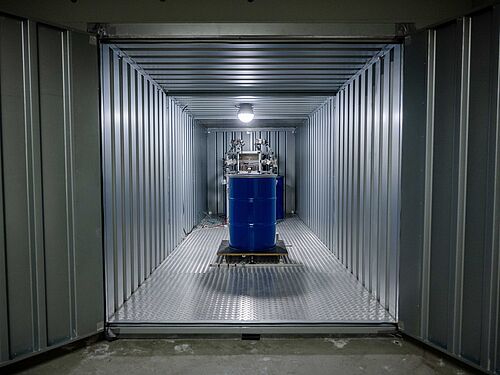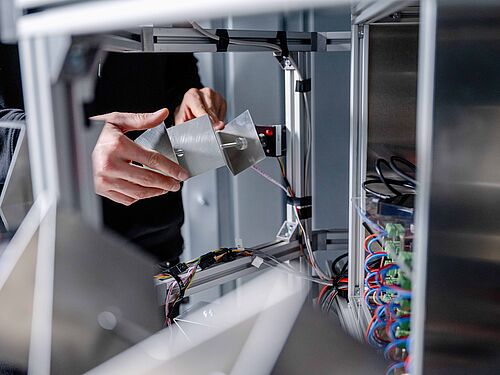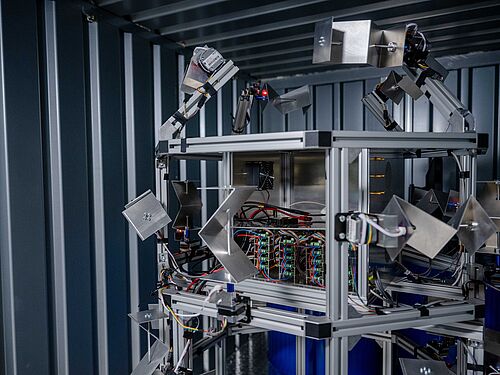An international research team has proposed a new method for monitoring nuclear disarmament treaties. The IT security experts developed a mechanism that uses radio waves to remotely monitor whether any changes are being made in a specific room. The researchers describe how robust and secure the approach is in the journal Nature Communications, published online on 17 October 2023. Teams from the Max Planck Institute for Security and Privacy (MPI-SP) in Bochum, Ruhr University Bochum, the School of Public and International Affairs at Princeton University, the University of Connecticut, Harvard University, PHYSEC GmbH, and Technische Universität Berlin collaborated on the development.
The researchers approached their project from a scenario in which State A wants to ensure that there are no changes in State B’s nuclear weapons stockpile – and to do so without permanent on-site monitoring. Specifically, a major threat is indicated by the removal of stored nuclear warheads to prepare them for deployment. “Our system uses two antennas to record a radio fingerprint of the room,” explains Dr. Johannes Tobisch, who earned his PhD on this research field in the CASA Cluster of Excellence at Ruhr University Bochum and MPI-SP and has since moved on to work in industry. One of the antennas emits a radio signal that is reflected off the walls and objects in the room. The other antenna records the signal. The recorded signal is characteristic: if the objects were moved only minimally, this would noticeably change the radio fingerprint. Major changes, such as the removal of a stored nuclear warhead, can thus be reliably detected.
Mirrors to guarantee security
However, this method can only work if state B measures the radio fingerprint at precisely the time when state A requests it. It’s therefore necessary to prevent State B from recording the radio fingerprint and sending the recording instead of a just-measured signal. “That would be like someone sticking a photo in front of a surveillance camera,” illustrates Johannes Tobisch.
For this reason, a setup with 20 rotating mirrors is initially installed in the room that is to be monitored. If the position of the mirrors changes, the radio fingerprint also changes. State A would record the radio fingerprints for different mirror positions during a one-time on-site visit and store them in a secret database. Periodically, State A could remotely request State B to send the radio fingerprint for a particular mirror position – and compare the measured data with the record in their secret database. If the data don’t match, there must have been a change in the room.
“Seventy percent of the world nuclear weapons are kept in storage for military reserve or awaiting dismantlement,“ outlines Dr. Sebastien Philippe from Princeton University the importance of such a technique. “The presence and number of such weapons at any given site cannot be verified easily via satellite imagery or other means that are unable to see into the storage vaults. Because of the difficulties to monitor them, these 9,000 nuclear weapons are not accounted for under existing nuclear arms control agreements. This new verification technology addresses this long-standing challenge and contributes to future diplomatic efforts that would seek to limit all nuclear weapon types.”
Setup in a field test
To test the idea, the researchers set up a container with movable barrels on the campus of Ruhr University Bochum, Germany, which they monitored using radio wave technology. Using this setup, they showed that radio fingerprints could be reliably reproduced for individual mirror settings. Different mirror settings also produced a variety of easily distinguishable radio fingerprints. If the researchers moved one of the barrels in the container, a few millimeters of displacement were enough to show up in the radio fingerprint.
The team also analyzed whether it’s possible to decipher how mirror positions and radio fingerprints correspond to each other using machine learning. Algorithms can indeed predict radio fingerprints if they recognize a number of mirror positions and the corresponding radio signals. Finding the connection, however, takes longer the more mirrors there are in the setup. “With 20 mirrors, it would take eight weeks for an attacker to decode the underlying mathematical function,” points out Johannes Tobisch, adding: “Because of the scalability of the system, it’s possible to increase the security factor even more.”
“The technology combines cyber-physical security assessments, previously only possible on data and security chips, with cross-system physics in a completely new way. This enables new levels of trust, especially for the Internet of Things,” says Professor Christian Zenger, head of the Secure Mobile Communication research group at Ruhr University Bochum and CEO of PHYSEC GmbH.
“This research project is an excellent example of how novel technologies at the interface between security engineering and radio technologies can be used to solve problems that are of great importance to society,” says Professor Christof Paar of the Max Planck Institute in Bochum.
“At a time of heightened geopolitical tensions and with a new nuclear arms race brewing, this work is particularly timely and relevant,” concludes Sébastien Philippe.
Funding
The research was funded by the U.S. Department of Energy/National Nuclear Security Administration (DE-NA 0002534), the Carnegie Corporation of New York, the German Research Foundation as part of its Excellence Strategy (Grant 39078197, EXC 2092), a Simons Investigator Fellowship, the National Science Foundation (Grant DMS-2134157), the Defense Advanced Research Projects Agency (Grant W911NF2010021), the Department of Energy (Grant DE-SC0022199) and an Air Force Office of Scientific Research Award FA9550-21-1-0039.
Original publication
Johannes Tobisch, Sébastien Philippe, Boaz Barak, Gal Kaplun, Christian Zenger, Alexander Glaser, Christof Paar, Ulrich Rührmair: Remote inspection of adversary-controlled environments, in: Nature Communications, 2023, DOI: 10.1038/s41467-023-42314-2
Press contact
Dr. Falk Schellenberg
Scientific Coordinator
Max Planck Institute for Security and Privacy
Germany
Phone: +49 234 90498 102
Email: pr(at)mpi-sp.org
Dr. Johannes Tobisch
formerly of Ruhr University Bochum and Max Planck Institute for Security and Privacy
Germany
Email: johannes.tobisch(at)ruhr-uni-bochum.de
Prof. Dr. Christian Zenger
Secure Mobile Communication
Faculty of Electrical Engineering and Information Technology
Ruhr University Bochum
Germany
Email: christian.zenger(at)ruhr-uni-bochum.de
Dr. Sebastien Philippe
Program on Science and Global Security
School of Public and International Affairs
Princeton University
USA
E-Mail: sebastien(at)princeton.edu
General note: In case of using gender-assigning attributes we include all those who consider themselves in this gender regardless of their own biological sex.




